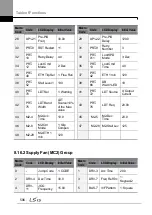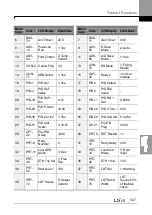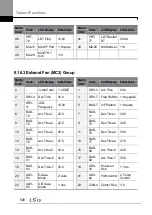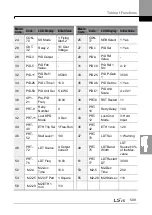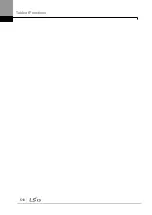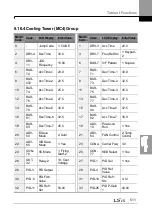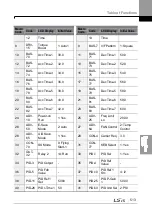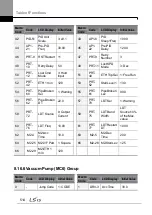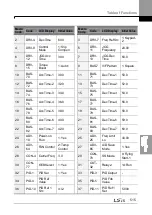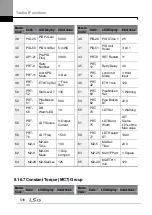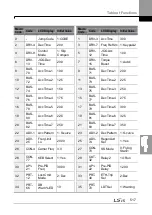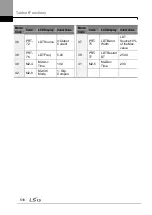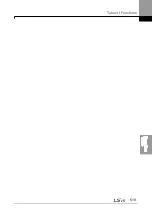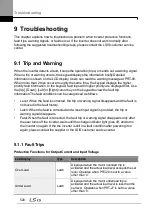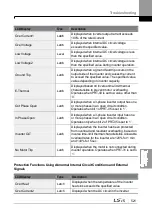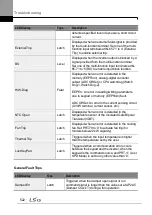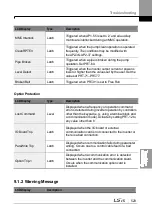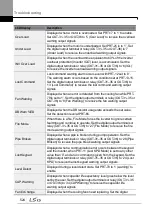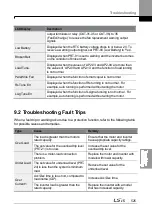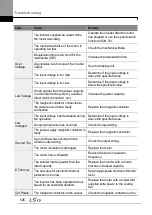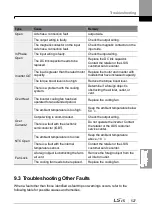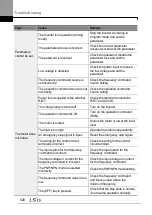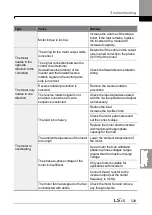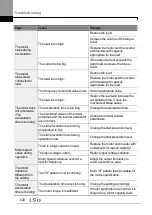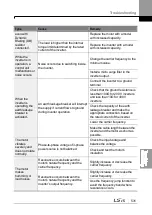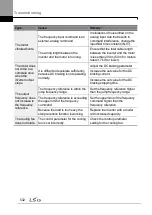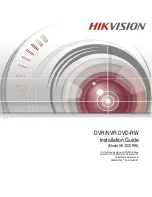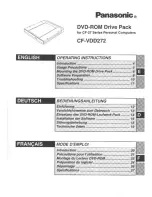
Troubleshooting
520
9 Troubleshooting
This chapter explains how to troubleshoot a problem when inverter protective functions,
fault trips, warning signals, or faults occur. If the inverter does not work normally after
following the suggested troubleshooting steps, please contact the LSIS customer service
center.
9.1 Trip and Warning
When the inverter detects a fault, it stops the operation (trips) or sends out a warning signal.
When a trip or warning occurs, the keypad displays the information briefly.Detailed
information is shown on the LCD display. Users can read the warning message at PRT-90.
When more than 2 trips occur at roughly the same time, the keypad displays the higher
priority fault information. In the keypad, fault trips with higher priority are displayed first. Use
the [Up], [Down], [Left] or [Right] cursor key on the keypad to view the fault trip
information.The fault conditions can be categorized as follows
•
Level: When the fault is corrected, the trip or warning signal disappears and the fault is
not saved in the fault history.
•
Latch: When the fault is corrected and a reset input signal is provided, the trip or
warning signal disappears.
•
Fatal: When the fault is corrected, the fault trip or warning signal disappears only after
the user turns off the inverter, waits until the charge indicator light goes off, and turns
the inverter on again. If the the inverter is still in a fault condition after powering it on
again, please contact the supplier or the LSIS customer service center.
9.1.1 Fault Trips
Protection Functions for Output Current and Input Voltage
LCD Display
Type
Description
Over Load
Latch
Displayed when the motor overload trip is
activated and the actual load level exceeds the set
level. Operates when PRT-20 is set to a value
other than ‗0‘.
Under Load
Latch
Displayed when the motor underload trip is
activated and the actual load level is less than the
set level. Operates when PRT-27 is set to a value
other than ‗0‘.
Summary of Contents for H100
Page 14: ......
Page 18: ...Preparing the Installation 4 37 90 kW 3 Phase ...
Page 27: ...Preparing the Installation 13 ...
Page 47: ...33 Installing the Inverter ...
Page 48: ...Installing the Inverter 34 Input and Output Control Terminal Block Wiring Diagram ...
Page 61: ...47 Installing the Inverter ...
Page 71: ...Learning to Perform Basic Operations 57 ...
Page 88: ...Learning to Perform Basic Operations 74 ...
Page 103: ...89 Learning Basic Features Code Description V1 Quantizing ...
Page 129: ...115 Learning Basic Features ...
Page 140: ...Learning Basic Features 126 ...
Page 148: ...Learning Basic Features 134 ...
Page 171: ...157 Learning Advanced Features Deceleration dwell operation ...
Page 183: ...169 Learning Advanced Features ...
Page 184: ...Learning Advanced Features 170 PID Command Block ...
Page 185: ...171 Learning Advanced Features PID Feedback Block ...
Page 186: ...Learning Advanced Features 172 PID Output Block ...
Page 187: ...173 Learning Advanced Features PID Output Mode Block ...
Page 197: ...183 Learning Advanced Features ...
Page 201: ...187 Learning Advanced Features Code Description 100 EPID1 Control block ...
Page 202: ...Learning Advanced Features 188 EPID2 Control block ...
Page 237: ...223 Learning Advanced Features Time Period Schedule AP3 38 Except3 Day 01 01 ...
Page 244: ...Learning Advanced Features 230 ...
Page 259: ...245 Learning Advanced Features Code Description Code Description Volt ...
Page 362: ...Learning Protection Features 348 ...
Page 415: ...401 RS 485 Communication Features Item Standards Parity check None ...
Page 524: ...Table of Functions 510 ...
Page 533: ...Table of Functions 519 ...
Page 547: ...533 Troubleshooting ...
Page 585: ...Technical Specification 571 ...
Page 594: ...580 ...
Page 595: ...581 ...
Page 596: ...582 ...

